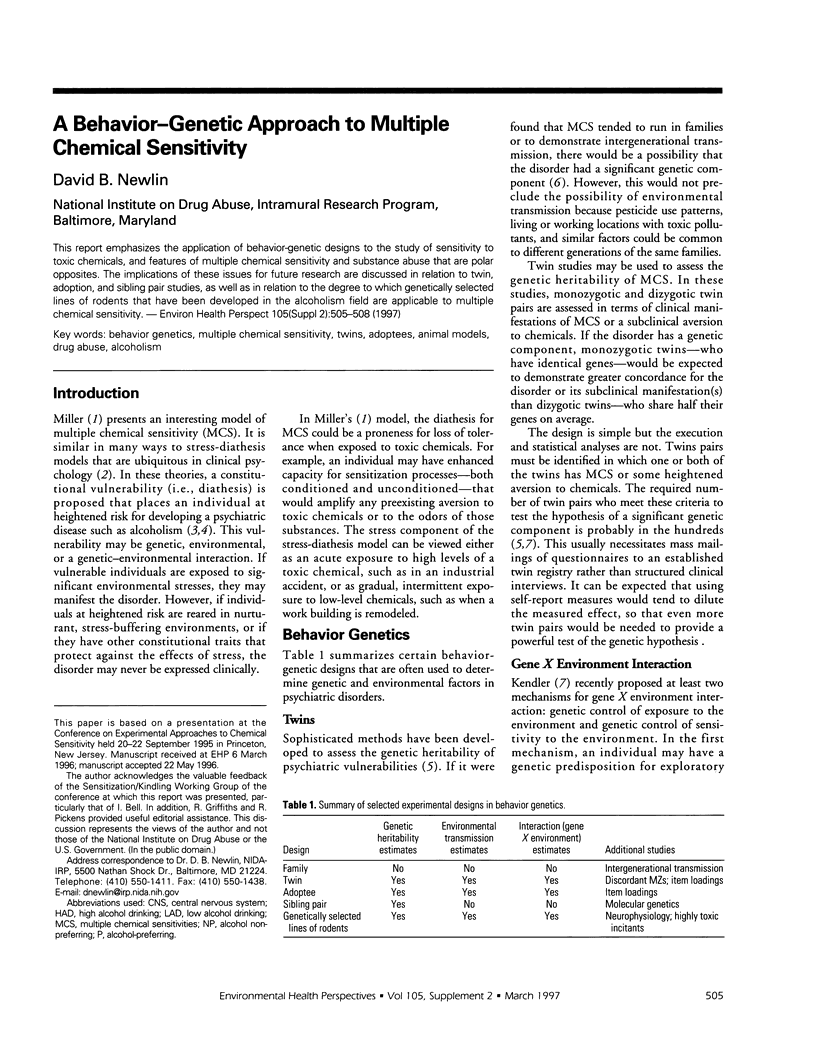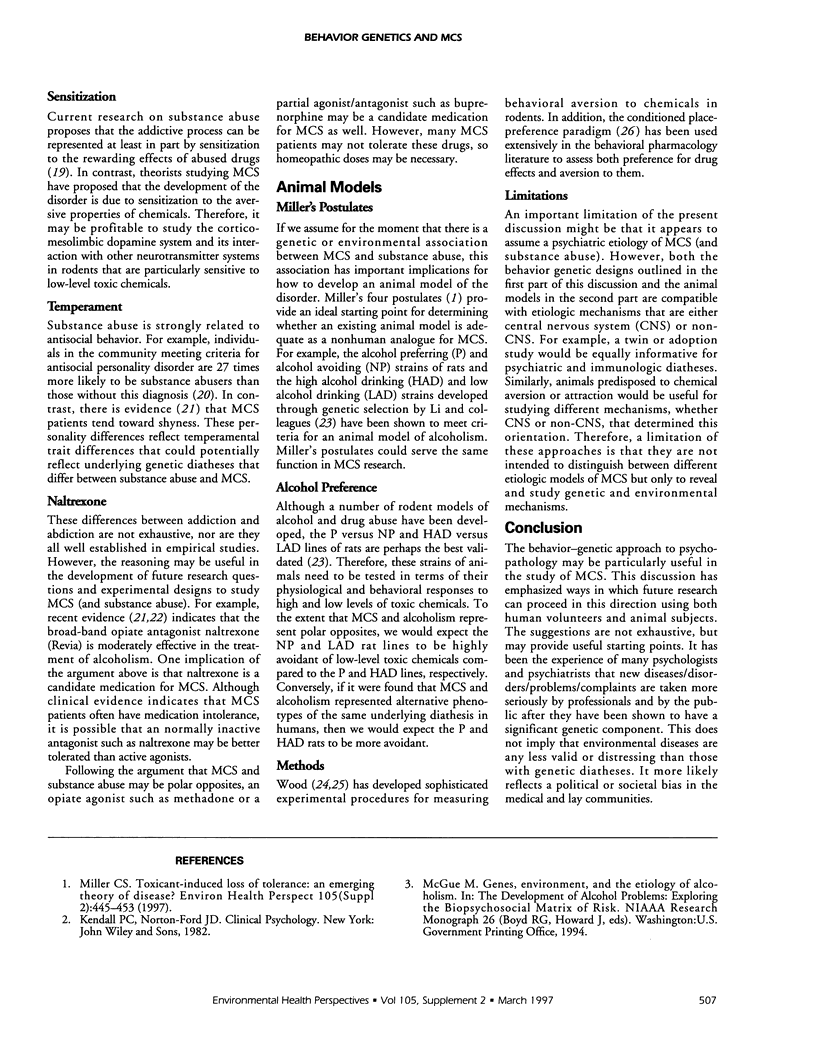Abstract
This report emphasizes the application of behavior-genetic designs to the study of sensitivity to toxic chemicals, and features of multiple chemical sensitivity and substance abuse that are polar opposites. The implications of these issues for future research are discussed in relation to twin, adoption, and sibling pair studies, as well as in relation to the degree to which genetically selected lines of rodents that have been developed in the alcoholism field are applicable to multiple chemical sensitivity.
Full text
PDF



Selected References
These references are in PubMed. This may not be the complete list of references from this article.
- Bell I. R., Peterson J. M., Schwartz G. E. Medical histories and psychological profiles of middle-aged women with and without self-reported illness from environmental chemicals. J Clin Psychiatry. 1995 Apr;56(4):151–160. [PubMed] [Google Scholar]
- Cadoret R. J., Troughton E., O'Gorman T. W., Heywood E. An adoption study of genetic and environmental factors in drug abuse. Arch Gen Psychiatry. 1986 Dec;43(12):1131–1136. doi: 10.1001/archpsyc.1986.01800120017004. [DOI] [PubMed] [Google Scholar]
- Cardon L. R., Smith S. D., Fulker D. W., Kimberling W. J., Pennington B. F., DeFries J. C. Quantitative trait locus for reading disability on chromosome 6. Science. 1994 Oct 14;266(5183):276–279. doi: 10.1126/science.7939663. [DOI] [PubMed] [Google Scholar]
- Fulker D. W., Cardon L. R. A sib-pair approach to interval mapping of quantitative trait loci. Am J Hum Genet. 1994 Jun;54(6):1092–1103. [PMC free article] [PubMed] [Google Scholar]
- Goodwin D. W., Schulsinger F., Hermansen L., Guze S. B., Winokur G. Alcohol problems in adoptees raised apart from alcoholic biological parents. Arch Gen Psychiatry. 1973 Feb;28(2):238–243. doi: 10.1001/archpsyc.1973.01750320068011. [DOI] [PubMed] [Google Scholar]
- Hashimoto L., Habita C., Beressi J. P., Delepine M., Besse C., Cambon-Thomsen A., Deschamps I., Rotter J. I., Djoulah S., James M. R. Genetic mapping of a susceptibility locus for insulin-dependent diabetes mellitus on chromosome 11q. Nature. 1994 Sep 8;371(6493):161–164. doi: 10.1038/371161a0. [DOI] [PubMed] [Google Scholar]
- Kendler K. S. Genetic epidemiology in psychiatry. Taking both genes and environment seriously. Arch Gen Psychiatry. 1995 Nov;52(11):895–899. doi: 10.1001/archpsyc.1995.03950230009003. [DOI] [PubMed] [Google Scholar]
- Knapp M., Wassmer G., Baur M. P. The relative efficiency of the Hardy-Weinberg equilibrium-likelihood and the conditional on parental genotype-likelihood methods for candidate-gene association studies. Am J Hum Genet. 1995 Dec;57(6):1476–1485. [PMC free article] [PubMed] [Google Scholar]
- Miller C. S. Toxicant-induced loss of tolerance--an emerging theory of disease? Environ Health Perspect. 1997 Mar;105 (Suppl 2):445–453. doi: 10.1289/ehp.97105s2445. [DOI] [PMC free article] [PubMed] [Google Scholar]
- Mucha R. F., Herz A. Motivational properties of kappa and mu opioid receptor agonists studied with place and taste preference conditioning. Psychopharmacology (Berl) 1985;86(3):274–280. doi: 10.1007/BF00432213. [DOI] [PubMed] [Google Scholar]
- O'Malley S. S., Jaffe A. J., Chang G., Schottenfeld R. S., Meyer R. E., Rounsaville B. Naltrexone and coping skills therapy for alcohol dependence. A controlled study. Arch Gen Psychiatry. 1992 Nov;49(11):881–887. doi: 10.1001/archpsyc.1992.01820110045007. [DOI] [PubMed] [Google Scholar]
- Pickens R. W., Svikis D. S., McGue M., Lykken D. T., Heston L. L., Clayton P. J. Heterogeneity in the inheritance of alcoholism. A study of male and female twins. Arch Gen Psychiatry. 1991 Jan;48(1):19–28. doi: 10.1001/archpsyc.1991.01810250021002. [DOI] [PubMed] [Google Scholar]
- Stewart J., de Wit H., Eikelboom R. Role of unconditioned and conditioned drug effects in the self-administration of opiates and stimulants. Psychol Rev. 1984 Apr;91(2):251–268. [PubMed] [Google Scholar]
- Volpicelli J. R., Alterman A. I., Hayashida M., O'Brien C. P. Naltrexone in the treatment of alcohol dependence. Arch Gen Psychiatry. 1992 Nov;49(11):876–880. doi: 10.1001/archpsyc.1992.01820110040006. [DOI] [PubMed] [Google Scholar]
- Waller M. B., McBride W. J., Gatto G. J., Lumeng L., Li T. K. Intragastric self-infusion of ethanol by ethanol-preferring and -nonpreferring lines of rats. Science. 1984 Jul 6;225(4657):78–80. doi: 10.1126/science.6539502. [DOI] [PubMed] [Google Scholar]
- Wood R. W. Behavioral evaluation of sensory irritation evoked by ammonia. Toxicol Appl Pharmacol. 1979 Aug;50(1):157–162. doi: 10.1016/0041-008x(79)90503-9. [DOI] [PubMed] [Google Scholar]
- Wood R. W. Determinants of irritant; termination behavior. Toxicol Appl Pharmacol. 1981 Nov;61(2):260–268. doi: 10.1016/0041-008x(81)90416-6. [DOI] [PubMed] [Google Scholar]


